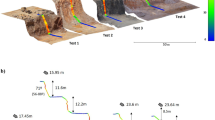Summary
This paper presents the methodology adopted for assessing experimental parameters relevant to computer rockfall analyses and describes the data gathered from several in situ rockfall tests carried out by ISMES and ENEL CRIS during recent years.
Through the calculation of block velocities during their fall from and onto slopes of various geometry, and the measurement of the run-out distances, heights of bounce and the geometric characteristics of blocks, the following experimental parameters were studied: Restitution Coefficient, Rolling Friction Coefficient, dispersion of trajectories, effect of block geometry on its fall, and efficiency of a ditch, at the bottom of a slope, for arresting fallen blocks.
Similar content being viewed by others
References
Aste, J. P., Falcetta, J. L. (1987): Ecroulements de masses rocheuses, B.R.G.M., Lyon.
Azimi, C., Desvarreux, P., Giraud, A., Martin Cocher, J. (1982): Methode de calcul de la dynamique des chutes de blocks. Application a' l'etude du versant de la montagne de la Pale (vercors). Bull. Liaison Labo P. Ch. 122, 93–102.
Azzoni, A. (1993): Methods for predicting rockfalls. MSc Dissertation, Imperial College of Science, Technology and Medicine, London.
Azzoni, A., Drigo, E., Giani, G. P., Rossi, P. P., Zaninetti, A. (1992): In situ observation of rockfall analysis parameters. In: Proc., 6th Int. Symposium on Landslides, Christchurch, 307–314.
Bozzolo, D., Pamini, R. (1982): Modello matematico per lo studio della caduta dei massi, Laboratorio di fisica terrestre-ICTS, Lugano-Trevano.
Bozzolo, D., Pamini, R. (1986): Simulation of rock falls down a valley side. Acta Mech. 63/1–4, 113–130.
Broili (1977): Relations between scree slope morphometry and dynamics of accumulation processes. In: Proc., Meeting on Rockfall Dynamics and Protective Works Effectiveness, Bergamo, Pub. ISMES n 90, 11–24.
Camponuovo, G. F. (1977) ISMES experience on the model of St. Martino. In: Proc., Meeting on Rockfall Dynamics and Protective Works Effectiveness, Bergamo, Publ. ISMES nr.90, 25–39.
Descocudres, F., Zimmermann, T. (1987): Three dimensional dynamic calculation of rockfalls. In: Proc., 6th Int. Congress on Rock Mechanics, Montreal, 337–342.
Giani, G. P. (1992). Rock slope stability analysis, Balkema, Rotterdam, pp. 1–361.
Hoek, E. (1987): A program in Basic for the analysis of rockfalls from slopes, Unpublished Notes.
Mak, N., Blomfield, D. (1986): Rock trap design for pre-splitting slopes. Conference on Rock Engineering in an Urban Environment, Inst. Mining Metallurgy, Hong Kong, 263–270.
Pfeiffer, T. J., Bowen, T. D. (1989): Computer simulation of rockfalls. Bull. Assoc. Engng. Geol. XXVI (1), 135–146.
Piteau, D. R. (1977): Computer rockfall model. In: Proc., Meeting on Rockfall Dynamics and Protective Works Effectiveness, Bergamo, Publ. ISMES nr.90, 123–125.
Richards, L. R. (1986): Rockfall protection: a review of current analytical and design methods. Secondo Ciclo di Conferenze di Meccanica e Ingegneria delle Rocce, MIR, Politecnico di Torino, pp. 11.1–11.13.
Ritchie, R. M. (1963): Evaluation of rockfalls and its control. Highways Res. Rec. 17, 14–28.
Robotham, M. E., Wangh, H., Walton, G. (1994): Assessment of rockfall from active and abandoned quarry slopes. In: Proc., Conference on Risk Assessment in the Extractive Industries, University of Exeter, UK, pp. 1–17.
Spang, R. M., Rautenstrauch, R. W. (1988): Empirical and mathematical approaches to rockfall protection and their practical application. In: Proc., 5th Int. Symposium on Landslides, Lausanne, 1237–1243.
Statham, I. (1979): A simple dynamic model of rockfall: some theoretical principles and field experiments. Int. Colloquium on Physical and Geomechanical Models, ISMES Bergamo, 237–258.
Whiteside, P. G. D. (1986): Discussion on rockfall protection measures. Conference on Rock Engineering in an Urban Environment, Inst. Mining and Metallurgy, Hong Kong, 490–492.
Author information
Authors and Affiliations
Rights and permissions
About this article
Cite this article
Azzoni, A., de Freitas, M.H. Experimentally gained parameters, decisive for rock fall analysis. Rock Mech Rock Engng 28, 111–124 (1995). https://doi.org/10.1007/BF01020064
Issue Date:
DOI: https://doi.org/10.1007/BF01020064




